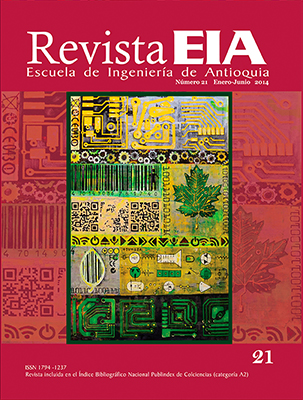IDENTIFICACIÓN DE HIDROCARBUROS AROMÁTICOS POLICÍCLICOS (HAPS) EN EL AIRE DE CÚCUTA-COLOMBIA: EFECTO GEN TÓXICO
IDENTIFICACIÓN DE HIDROCARBUROS AROMÁTICOS POLICÍCLICOS (HAPS) EN EL AIRE DE CÚCUTA-COLOMBIA: EFECTO GEN TÓXICO


This work is licensed under a Creative Commons Attribution-NonCommercial-NoDerivatives 4.0 International License.
Copyright statement
The authors exclusively assign to the Universidad EIA, with the power to assign to third parties, all the exploitation rights that derive from the works that are accepted for publication in the Revista EIA, as well as in any product derived from it and, in in particular, those of reproduction, distribution, public communication (including interactive making available) and transformation (including adaptation, modification and, where appropriate, translation), for all types of exploitation (by way of example and not limitation : in paper, electronic, online, computer or audiovisual format, as well as in any other format, even for promotional or advertising purposes and / or for the production of derivative products), for a worldwide territorial scope and for the entire duration of the rights provided for in the current published text of the Intellectual Property Law. This assignment will be made by the authors without the right to any type of remuneration or compensation.
Consequently, the author may not publish or disseminate the works that are selected for publication in the Revista EIA, neither totally nor partially, nor authorize their publication to third parties, without the prior express authorization, requested and granted in writing, from the Univeridad EIA.
Show authors biography
RESUMEN
En los últimos tiempos ha tomado un gran auge en los países del tercer mundo, incluidos los de América Latina, el estudio de la exposición humana a las emisiones de combustión, incluyendo las partículas ultrafinas (PM2,5) y componentes mutagénicos y carcinógenos como los hidrocarburos aromáticos policíclicos (HAPs). En este trabajo se identificó en la ciudad de Cúcuta un grupo de HAPs reconocidos por su afectación a la salud de la población; los HAPs encontrados fueron: metilcriseno, benzo[a]antraceno, benzo[j]fluoranteno, benzo[b] fluoranteno, benzo[a] pireno, dibenzo [a,l] pireno, dibenzo[a,e] pireno, benzo[c] fluoreno, benzo[k] fluoranteno, Indeno[1,2,3-cd] pireno, dibenzo[a,h]antraceno y benzo[g,h.i]perileno. Adicionalmente también se evaluó in vitro usando el ensayo cometa, el efecto genotóxico del material particulado PM2,5 extraído con acetona y diclorometano.
ABSTRACT
The study of human exposure to combustion emissions, including ultrafine particulate matter (PM2,5) has increased recently in the thirld world countries, including those in Latin America. This paper identifies a group of polyciclic aromatic hydrocarbons (PAHs) in the city of Cúcuta, Colombia. Those PAHs are recognized by their effects on human health. PAHs found were: Methylchrysene, Benzo [a] anthracene, Benzo [j ] fluoranthene, Benzo [b] fluoranthene, Benzo [a] pyrene, dibenzo [a, l] pyrene, dibenzo [a, e] pyrene, Benzo [c] fluorene, benzo [k] fluoranthene, indeno [1,2,3 -cd] pyrene, dibenzo [a, h] anthracene and benzo [g, hi] perylene. The genotoxic effect of the particulate matter extracted with acetone and dichlorometane, was also evaluated in vitro using the commet assay.
Article visits 697 | PDF visits 298
